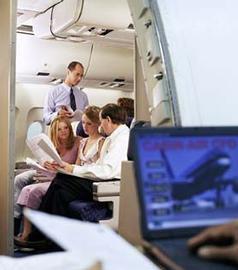The ACE facility is unique in Europe and will enable testing of aircraft cabin environments during real-time simulated flights, with up to 40 volunteer passengers and crew on-board. Initially the rig will be used as part of the EU's Friendly Aircraft Cabin Environment project which aims to improve environmental comfort for passengers, while the Health Effects in Aircraft Cabin Environment project will look at the impact on flight and cabin crew.
Initially the project team is looking at a robust set of tests to provide parameters that can be used to build a human response model for use at the design stage. The principle parameters under test are noise, vibration, temperature, relative humidity, air velocity, air distribution and recirculation.
Conditions in the aircraft are recreated based on measurements taken during actual commercial flights by teams of researchers from BRE. So why not just use these flights to carry out the research? As David Butler, principal consultant at BRE explains: "What you can't do on a commercial flight is instrument the flight attendants and the pilot. Also on a commercial airline we cannot carry out repeatable tests, in this facility we can control in a scientific way the noise and vibration as well as the environment – the temperature and humidity."
The test rig uses the forward fuselage of an Airbus A300 comprising of the flightdeck, passenger cabin and two galleys, and space at the rear for researchers. BRE tracked down the aircraft at Bournemouth airport and brought it back to Garston where it set about creating a facility that would mirror, as practically as possible, a modern wide bodied aircraft.
Environmental simulation
David Butler has been responsible for setting up the environmental conditioning system. Recreating realistic conditions meant developing an air conditioning system capable of supplying air at very low relative humidity. "If you're cruising at 38 000 ft you're drawing air in from outside which is at -57°C," says Butler. "The moisture bearing capability of air at that temperature is virtually zero, trying to simulate that at sea level is very difficult." To achieve this the system is based around a desiccant dehumidifier which dries the air out to extremely low levels, which subsequently needs recooling. Prior to being supplied to the aircraft cabin the air is passed through two levels of filtration: pre filters and hepa filters equivalent to those found in a commercial airliner.
The Airbus has been cocooned in a purpose built shed. Air inside this is cooled to 5-10°C to reduce the thermal loads on the aircraft, while surfaces of the walls and the windows in the main cabin are cooled by water glycol solution circulating through reinforced pvc pipework at around 0°C. The facility has also been designed to be as flexible as possible and has the capability of being run throughout the entire year. The majority of the fans are inverter controlled and airflow into the cabin can be varied as can the amount of recirculation which can be altered from anything between zero and 60%. Generally supply is in the region of 10 litres/s/person, comparable with a typical air-conditioned building. Relative humidities in the cockpit have been taken down to as low as 6% during tests and to below 10% in the main cabin. "This is comparable to what we've measured on real flights," says Butler.
Instrumentation to measure temperature and relative humidity is installed at various points within the cabin along with cctv cameras to record passenger response and movements. Air samples are also taken which will be analysed for odours, volatile organic compounds and various other substances.
Monitoring is carried out during the simulation of both the pilot and the cabin crew, this includes measurements for skin temperature, conductance, body movement and heart rate for feedback on areas such as health, comfort and stress levels. The pilot also wears an electroencephalogram cap to record brain activity. Volunteer passengers are asked to complete a number of questionnaires before, during and after the flight, as are the cabin crew who also undertake tests to check parameters such as alertness, reaction times and mood.
Shakers built-into the aircraft body replicates noise and vibration associated with taxing, take-off, cruising and landing. Thirty five small shakers vibrate the walls producing a wave of noise mirroring that transmitted from the engines, while three large shakers underneath the aircraft reproduce the floor vibrations. A series of microphones around the cabin interior calculates the necessary signal to feed to the shaker units.
Results from the current tests will help establish what the environmental conditions in aircraft really are and what are the crucial factors. Only then can the environment for both passengers and crew be improved.
Source
Building Sustainable Design























No comments yet